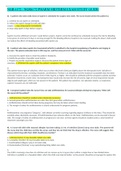Exam (elaborations)
NGR 6172Pharm Midterm.
- Course
- Institution
NGR 6172 / NGR6172 PHARM MIDTERM EXAM STUDY GUIDE 1). A patient who takes daily doses of aspirin is scheduled for surgery next week. The nurse should advise the patient to: a. continue to use aspirin as scheduled. b. reduce the aspirin dosage by half until after surgery. c. stop using aspiri...
[Show more]



